水稻形态学
- 格式:doc
- 大小:3.89 MB
- 文档页数:34
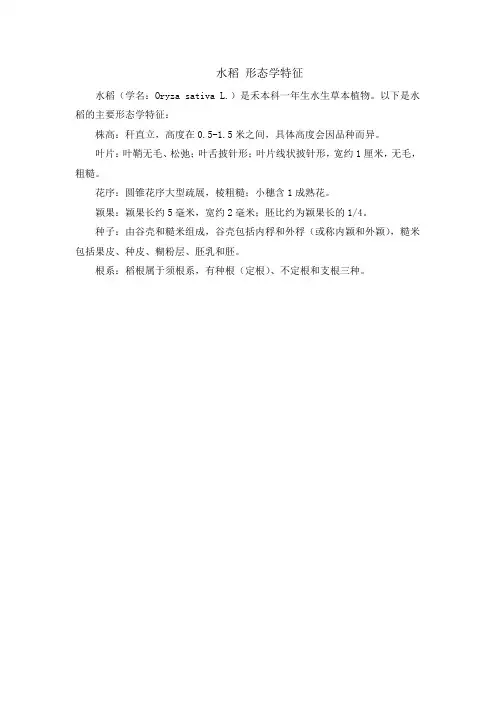
水稻形态学特征
水稻(学名:Oryza sativa L.)是禾本科一年生水生草本植物。
以下是水稻的主要形态学特征:
株高:秆直立,高度在0.5-1.5米之间,具体高度会因品种而异。
叶片:叶鞘无毛、松弛;叶舌披针形;叶片线状披针形,宽约1厘米,无毛,粗糙。
花序:圆锥花序大型疏展,棱粗糙;小穗含1成熟花。
颖果:颖果长约5毫米,宽约2毫米;胚比约为颖果长的1/4。
种子:由谷壳和糙米组成,谷壳包括内稃和外稃(或称内颖和外颖),糙米包括果皮、种皮、糊粉层、胚乳和胚。
根系:稻根属于须根系,有种根(定根)、不定根和支根三种。
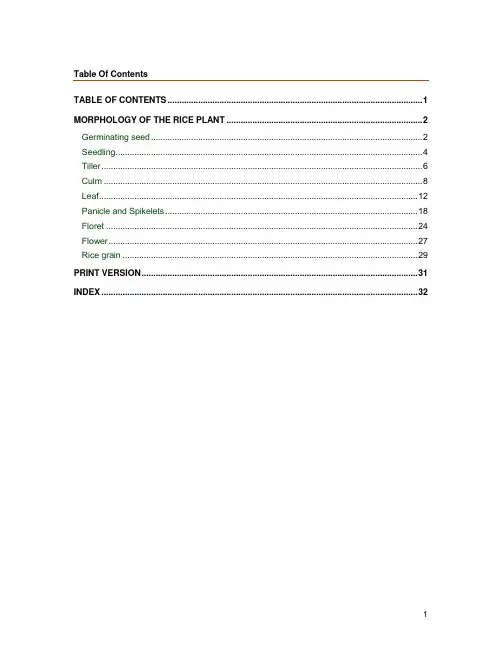
Table Of ContentsTABLE OF CONTENTS (1)MORPHOLOGY OF THE RICE PLANT (2)Germinating seed (2)Seedling (4)Tiller (6)Culm (8)Leaf (12)Panicle and Spikelets (18)Floret (24)Flower (27)Rice grain (29)PRINT VERSION (31)INDEX (32)Morphology of the Rice PlantGerminating seedWhen the seed germinates in well-drained and well-aerated soil, the coleorhiza, a covering enclosing the radicle or primary root, protrudes first.Fig. 1 - The coleorhiza protrudes first.Shortly after the coleorhiza appears, the radicle or primary root breaks through the covering. Fig. 2 - Radicle or primary root breaks through the covering.Two or more sparsely branched seminal roots follow. These roots eventually die and are replaced by many secondary adventitious roots.Fig. 3 - Seminal rootsIf the seed germinates in water, the coleoptile, a covering enclosing the young shoot, emerges ahead of the coleorhiza. The coleoptile emerges as a tapered cylinder.Fig. 4 - Coleoptile emerging as a tapered cylinder.SeedlingThe mesocotyl or basal portion of the coleoptile elongates when the seed germinates in soil, and in darkness. It pushes the coleoptile above the soil surface.Fig. 5 - Mesocotyl pushing the coleoptile above the soil surface.The first seedling leaf, or primary leaf, emerges from the growing seed. It is green and shaped like a cylinder. It has no blade. The second leaf is a complete leaf. It is differentiated into a leaf blade and a leaf sheath.Fig. 6 - First and second seedling leaf.TillerThe seedling will grow and develop branched tillers. Parts of the rice tiller include the roots, culm and leaves. Mature roots of the rice plant are fibrous and produce smaller roots called rootlets. All roots have root hairs to absorb moisture and nutrients.Fig. 7 - Parts of the rice tiller.There are two kinds of mature roots:1. secondary adventitious roots2. adventitious prop roots prop roots.Fig. 8 - Types of roots.Secondary adventitious roots are produced from the underground nodes of young tillers.Fig. 9 - Secondary adventitious roots.As the plant grows, coarse adventitious prop roots often form above the soil surface in whorls from the nodes of the culm.Fig. 10 - Adventitious prop roots.CulmThe culm, or jointed stem of the rice, is made up of a series of nodes and internodes. Fig. 11 - Culm, nodes, and internodes.Young internodes are smooth and solid. Mature internodes are hollow and finely grooved with a smooth outer surface. Generally, internodes increase in length from the lower to the upper portions of the plant. The lower internodes at the plant base are short and thick.Fig. 12 - Young and mature internodes.The node is the solid portion of the culm. The node or nodal region bears a leaf and a bud. The bud is attached to the upper portion of the node and is enclosed by the leaf sheath. The bud may give rise to a leaf or a tiller.Fig. 13 - Leaf, node, and bud.Early tillers arise from the main culm in an alternate pattern. Primary tillers originate from the lowermost nodes and give rise to secondary tillers. Secondary tillers produce tertiary tillers. Fig. 14 - Primary tillers.Fig. 15 - Secondary tillers. Fig. 16 - Tertiary tillers.LeafThe node or nodal region of the culm will bear a leaf. Fig. 17 - Leaf.Leaves are borne alternately on the culm in opposite directions. One leaf is produced at each node. Varieties differ in the number of leaves produced.Fig. 18 - Leaves alternate on the culm in opposite directions.The topmost leaf below the panicle is the flag leaf. The flag leaf contributes largely to the filling of grains because it supplies photosynthetic products, mainly to the panicle.Fig. 19 - Flag leaf.The leaf sheath and leaf blade are continuous.Fig. 20 - Leaf sheath and blade.A circular collar joins the leaf blade and the leaf sheath.Fig. 21 - Leaf collar.The leaf sheath is wrapped around the culm above the node. Fig. 22 - Leaf sheath and culm.The swelling at the base of the leaf sheath, just above the node, is the sheath pulvinus. It is sometimes incorrectly referred to as the node.Fig. 23 - Sheath pulvinus.Leaf blades are generally flat. Varieties differ in blade length, width, thickness, area, shape, color, angle and pubescence.Fig. 24 - Different varieties with varying blade characteristics.With many parallel veins on the upper surface of the leaf, the underside of the leaf blade is smooth with a prominent ridge in the middle; the midrib.Fig. 25 - Parallel veins on upper surface. Fig. 26 - Leaf midrib.Most leaves possess small, paired ear-like appendages on either side of the base of the blade. These appendages are called auricles. Auricles may not be present on older leaves. Another leaf appendage is the ligule, a papery membrane at the inside juncture between the leaf sheath and the blade. It can have either a smooth or hair-like surface. The length, color, and shape of the ligule differ according to variety.Fig. 27 - Ligule and auricle.Although similar, rice seedlings are different from common grasses. While rice plants have both auricles and ligules, common grassy weeds found in rice fields normally do not have these features. These characteristics are often helpful in identifying weeds in rice fields when the plants are young.Fig. 28 - Rice and grassy weed comparison.Panicle and SpikeletsThe terminal component of the rice tiller is an inflorescence call the panicle. The inflorescence or panicle is borne on the uppermost internode of the culm. The panicle bears rice spikelets, which develop into grains.Fig. 29 - Rice panicle.The panicle base often appears as a hairlike ring and is used as a dividing point in measuring culm and panicle length. The panicle base is often called the neck.Fig. 30 - Panicle base (neck).The panicle axis is continuous and hollow except at the nodes where branches are borne. Fig. 31 - Panicle axis.The swellings at the panicle axis where the branches are borne are referred to as the panicle pulvinus.Fig. 32 - Panicle pulvinus.Each node on the main panicle axis gives rise to primary branches which in turn bears secondary branches. Primary branches may be arranged singly or in pairs.Fig. 33 - Secondary and primary branch.The panicles bear spikelets, most of which develop into grains. These spikelets are borne on the primary and secondary branches. The spikelet is the basic unit of the inflorescence and panicle. It consists of the pedicel and the floret.Fig. 34 - Spikelets.The floret is borne on the pedicel.Fig. 35 - Floret and pedicel.The rudimentary glumes are the laterally enlarged, cuplike apex of the pedicel. The rudimentary glumes are the lowermost parts of the spikelet. During threshing, the rudimentary glumes are separated from the rest of the spikelet.The sterile lemmas are small, bractlike projections attached to the floret. The rachilla is a small axis that bears the single floret. It is between the sterile lemmas and the floret.Fig. 36 - Rudimentary glumes, sterile lemmas, and rachilla.FloretThe rachilla, sterile lemmas and the rudimentary glumes all support the floret. The floret includes the lemma, palea, and the flower.Fig. 37 - FloretThe larger protective glume covering the floret is called the lemma and the smaller one is referred to as the palea.Fig. 38 - Palea and lemma.Both the lemma and palea have ridges referred to as nerves. The lemma has five while the palea has three. The middle nerve of the lemma can be either smooth or hairy.Fig. 39 - Nerves.The lemma has a constricted structure at its end called the keel. In some varieties, the keel is elongated into a thin extension, the awn.Fig. 40 - Awn and keel.FlowerThe floret contains a flower. The flower consists of a pistil (female organ) and six stamens (male organs).Fig. 41 - Pistil.Fig. 42 - Stamens.The stamens have two-celled anthers borne on slender filaments.Fig. 43 - Anthers and filaments.The pistil contains one ovule and bears a double-plumed stigma on a short style. Fig. 44 - Stigma, style, and ovule.At the flower’s base near the palea are two transparent structures known as lodicules. The lodicules thrust the lemma and palea apart at flowering to enable the elongating stamens to emerge out of the open floret. The lemma and palea close after the anthers have shed their pollen.Fig. 45 - Lodicule.Rice grainThe rice grain is the ripened ovary, with the lemma, palea, rachilla, sterile lemmas and the awn firmly attached to it.Fig. 46 - Rice grain.The rice hull includes the lemma and palea and their associated structures – the sterile lemmas, rachilla, and awn.Fig. 47 - Rice hulls.The dehulled rice grain is called caryopsis, commonly referred to as brown rice because of three brownish pericarp layers that envelope it. Next to the pericarp layers are the two tegmen layers and the aleurone layers.Fig. 48 - Tagmen, pericap, and aleurone layers.The remaining part of the grain consists of the endosperm and the embryo. The endosperm provides nourishment to the germinating embryo. The embryo lies on the belly side of the grain and is enclosed by the lemma. It is the embryonic organ of the seed.Fig. 49 - Endosperm and embryo.The embryo contains the plumule (embryonic leaves) and the radicle (embryonic primary root).Fig. 50 - Plumule and radicle.Print VersionCultural Control of Rice Insect Pests may also be completely printed, provided you have a printer attached to your computer and Microsoft Word. Click here to launch the entire contents of this course in Microsoft Word.IndexAAdventitious (4)Aleurone (24)Anthers (22)Asian (27)Awn (20)B Bractlike (15)C Caryopsis (24)Characteristics (10)Coleoptile..............................................................................................................................2, 3 portion .. (3)pushes (3)Coleorhiza (2)Contains (24)plumule (24)Culm ................................................................................................................... 4, 6, 10, 15, 27 measuring (15)portion (6)Cuplike (15)D Dehulled (24)Different (10)EEndosperm (24)FFirst (3)Flag (10)Floret ................................................................................................................................ 15, 20 Flower.. (22)Flower’s (22)G Germinating (2)seed (2)Glume (20)Glumes............................................................................................................................. 15, 20 I Index. (27)use (27)L Leaf..................................................................................................................................... 6, 10 Leaves. (10)Ligule (10)shape (10)Ligules (10)Lodicule (22)Lodicules (22)M Measuring (15)culm (15)Mesocotyl (3)Morphology (27)Rice Plant (27)Welcome (27)NNear (22)palea (22)Nerves (20)OOryza sativa (27)P Palea........................................................................................................................... 20, 22, 24 near .. (22)Panicle (15)Panicle pulvinus (15)Parallel (10)Parts ................................................................................................................................... 4, 15 spikelet .. (15)Pedicel (15)Pericap (24)Pericarp (24)Pistil (22)Plumule (24)contains (24)Portion...................................................................................................................................3, 6 coleoptile. (3)culm (6)Primary (6)Pulvinus........................................................................................................................... 10, 15 Pushes .. (3)coleoptile (3)RRachilla ...................................................................................................................... 15, 20, 24 Radicle .. (2)Rest (15)spikelet (15)Rice............................................................................................................................. 10, 15, 24Rice grain (24)Rice Morphology (27)Rice Plant (27)Morphology (27)Rice Production (27)Rudimentary glumes (15)SSearch (27)Secondary...................................................................................................................... 4, 6, 15 Seed. (2)Germinating (2)Seminal (2)Shape (10)ligule (10)Sheath pulvinus (10)Spikelet (15)parts (15)rest (15)Spikelets (15)Stamens (22)Stigma (22)TTagmen (24)Tertiary (6)The coleorhiza (2)These characteristics (10)These spikelets (15)Tiller (4)Types (4)U Use (27)Index (27)WWelcome (27)Morphology (27)Y Young (6)。
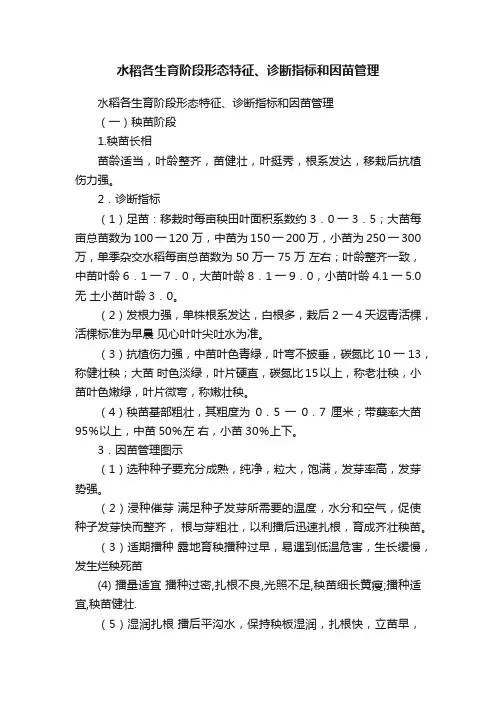
水稻各生育阶段形态特征、诊断指标和因苗管理水稻各生育阶段形态特征、诊断指标和因苗管理(一)秧苗阶段1.秧苗长相苗龄适当,叶龄整齐,苗健壮,叶挺秀,根系发达,移栽后抗植伤力强。
2.诊断指标(1)足苗:移栽时每亩秧田叶面积系数约3.0一3.5;大苗每亩总苗数为100一120 万,中苗为150一200万,小苗为250一300万,单季杂交水稻每亩总苗数为50万一75万左右;叶龄整齐一致,中苗叶龄6.1一7.0,大苗叶龄8.1一9.0,小苗叶龄4.1一5.0无土小苗叶龄3.0。
(2)发根力强,单株根系发达,白根多,栽后2一4天返青活棵,活棵标准为早晨见心叶叶尖吐水为准。
(3)抗植伤力强,中苗叶色青绿,叶弯不披垂,碳氮比10一13,称健壮秧;大苗时色淡绿,叶片硬直,碳氮比15以上,称老壮秧,小苗叶色嫩绿,叶片微弯,称嫩壮秧。
(4)秧苗基部粗壮,其粗度为0.5一0.7厘米;带蘖率大苗95%以上,中苗50%左右,小苗30%上下。
3.因苗管理图示(1)选种种子要充分成熟,纯净,粒大,饱满,发芽率高,发芽势强。
(2)浸种催芽满足种子发芽所需要的温度,水分和空气,促使种子发芽快而整齐,根与芽粗壮,以利播后迅速扎根,育成齐壮秧苗。
(3)适期播种露地育秧播种过早,易遇到低温危害,生长缓慢,发生烂秧死苗(4) 播量适宜播种过密,扎根不良,光照不足,秧苗细长黄瘦;播种适宜,秧苗健壮.(5)湿润扎根播后平沟水,保持秧板湿润,扎根快,立苗早,根芽生长健壮,成秧率高,播后深水,只长芽扎根,易引起倒芽、浮苗;如低温,还会引起烂秧、死苗。
要排水落干。
(6)早施断奶肥三叶期的秧苗,胚乳内养分已全部耗尽,它的生长靠自己的根系吸收水和养料,制造有机物质,独立生活。
追肥要早,一般在一叶一心时开始。
(7)防止死苗秧苗三叶期时,抗逆性最弱,遇5一7℃的低温,籼稻就会受到冷害,保温育秧或旱育秧,秧苗2一3叶时,由于病菌侵入,在遇低温阴雨转高温的晴天时,常出现青枯或黄枯死苗。
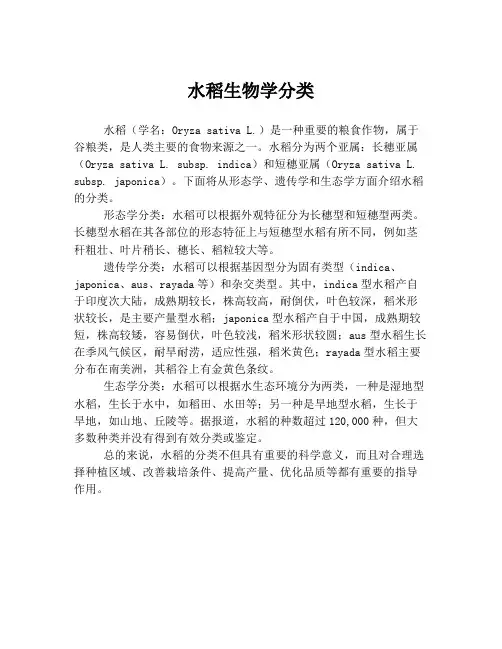
水稻生物学分类
水稻(学名:Oryza sativa L.)是一种重要的粮食作物,属于谷粮类,是人类主要的食物来源之一。
水稻分为两个亚属:长穗亚属(Oryza sativa L. subsp. indica)和短穗亚属(Oryza sativa L. subsp. japonica)。
下面将从形态学、遗传学和生态学方面介绍水稻的分类。
形态学分类:水稻可以根据外观特征分为长穗型和短穗型两类。
长穗型水稻在其各部位的形态特征上与短穗型水稻有所不同,例如茎秆粗壮、叶片稍长、穗长、稻粒较大等。
遗传学分类:水稻可以根据基因型分为固有类型(indica、japonica、aus、rayada等)和杂交类型。
其中,indica型水稻产自于印度次大陆,成熟期较长,株高较高,耐倒伏,叶色较深,稻米形状较长,是主要产量型水稻;japonica型水稻产自于中国,成熟期较短,株高较矮,容易倒伏,叶色较浅,稻米形状较圆;aus型水稻生长在季风气候区,耐旱耐涝,适应性强,稻米黄色;rayada型水稻主要分布在南美洲,其稻谷上有金黄色条纹。
生态学分类:水稻可以根据水生态环境分为两类,一种是湿地型水稻,生长于水中,如稻田、水田等;另一种是旱地型水稻,生长于旱地,如山地、丘陵等。
据报道,水稻的种数超过120,000种,但大多数种类并没有得到有效分类或鉴定。
总的来说,水稻的分类不但具有重要的科学意义,而且对合理选择种植区域、改善栽培条件、提高产量、优化品质等都有重要的指导作用。
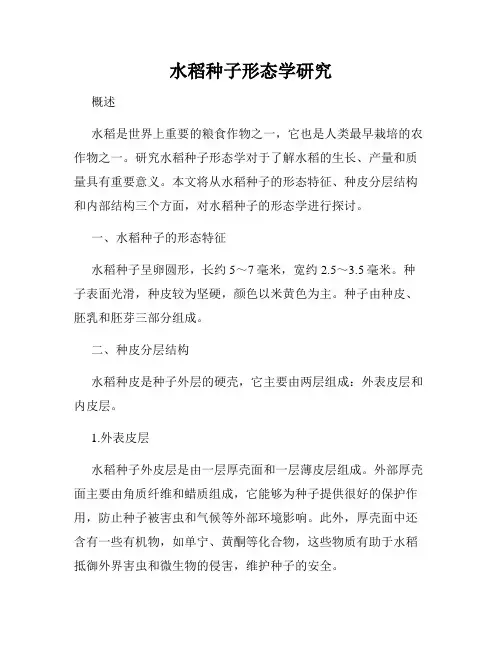
水稻种子形态学研究概述水稻是世界上重要的粮食作物之一,它也是人类最早栽培的农作物之一。
研究水稻种子形态学对于了解水稻的生长、产量和质量具有重要意义。
本文将从水稻种子的形态特征、种皮分层结构和内部结构三个方面,对水稻种子的形态学进行探讨。
一、水稻种子的形态特征水稻种子呈卵圆形,长约5~7毫米,宽约2.5~3.5毫米。
种子表面光滑,种皮较为坚硬,颜色以米黄色为主。
种子由种皮、胚乳和胚芽三部分组成。
二、种皮分层结构水稻种皮是种子外层的硬壳,它主要由两层组成:外表皮层和内皮层。
1.外表皮层水稻种子外皮层是由一层厚壳面和一层薄皮层组成。
外部厚壳面主要由角质纤维和蜡质组成,它能够为种子提供很好的保护作用,防止种子被害虫和气候等外部环境影响。
此外,厚壳面中还含有一些有机物,如单宁、黄酮等化合物,这些物质有助于水稻抵御外界害虫和微生物的侵害,维护种子的安全。
2.内皮层水稻种子内皮层主要由两层组成:外皮和内皮。
外皮是由木质素和黄酮类物质组成的,可为种子增加硬度和重量。
内皮主要由细胞壁和纤维素组成,能够使种子更加耐磨损和耐储藏。
三、水稻种子的内部结构水稻种子的内部结构主要由胚乳和胚芽两部分组成。
1.胚乳水稻种子胚乳由三部分组成:胚乳端膜、胚乳和外皮组成。
其中最外层的胚乳端膜是一层具有厚壁细胞的薄膜,可为种子提供保护。
中央的胚乳层主要由淀粉粒和蛋白质组成,是人类食物来源的主要部分。
内层的外皮是由单层细胞组成,主要具有保护和保湿的作用。
2.胚芽水稻种子的胚芽位于胚乳的一端,它是未来水稻植株的基础。
胚芽主要由芽头、第一叶和芽柄组成。
芽头是未来根系与茎管的发生处,第一叶则是第一个生长出来的叶子,一般呈半圆形。
芽柄则是将来植株茎管的生长基础。
结论通过水稻种子形态学的探讨和研究,我们可以了解水稻种子的基本结构和特征,这对于我们了解水稻的生长,繁殖和高质量的种植具有重要意义。
同时,水稻种子也是人类主要的粮食来源之一,研究水稻种子对于改善全球粮食供应和食品质量有很大帮助。

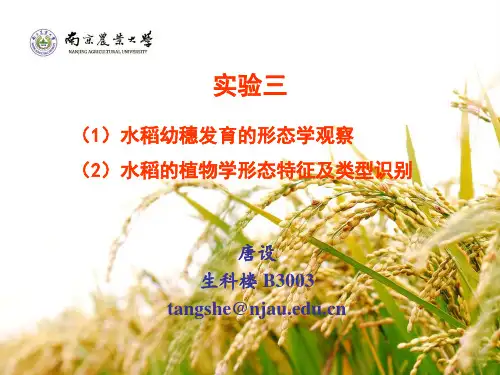
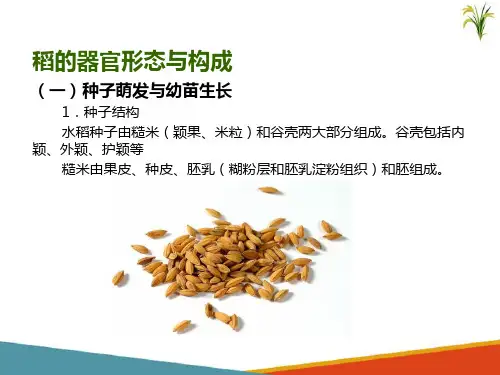
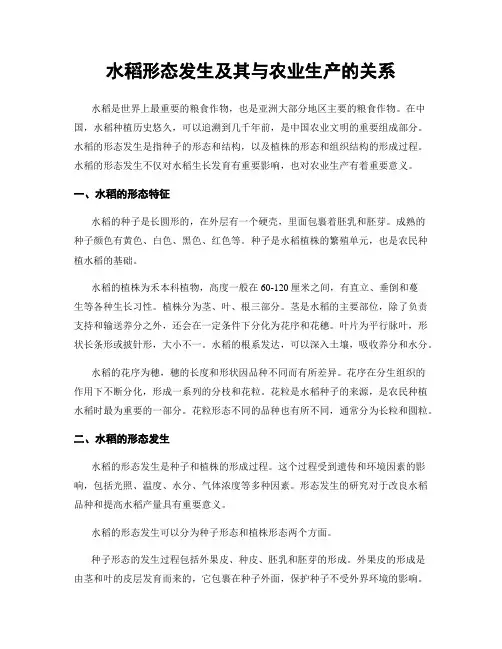
水稻形态发生及其与农业生产的关系水稻是世界上最重要的粮食作物,也是亚洲大部分地区主要的粮食作物。
在中国,水稻种植历史悠久,可以追溯到几千年前,是中国农业文明的重要组成部分。
水稻的形态发生是指种子的形态和结构,以及植株的形态和组织结构的形成过程。
水稻的形态发生不仅对水稻生长发育有重要影响,也对农业生产有着重要意义。
一、水稻的形态特征水稻的种子是长圆形的,在外层有一个硬壳,里面包裹着胚乳和胚芽。
成熟的种子颜色有黄色、白色、黑色、红色等。
种子是水稻植株的繁殖单元,也是农民种植水稻的基础。
水稻的植株为禾本科植物,高度一般在60-120厘米之间,有直立、垂倒和蔓生等各种生长习性。
植株分为茎、叶、根三部分。
茎是水稻的主要部位,除了负责支持和输送养分之外,还会在一定条件下分化为花序和花穗。
叶片为平行脉叶,形状长条形或披针形,大小不一。
水稻的根系发达,可以深入土壤,吸收养分和水分。
水稻的花序为穗,穗的长度和形状因品种不同而有所差异。
花序在分生组织的作用下不断分化,形成一系列的分枝和花粒。
花粒是水稻种子的来源,是农民种植水稻时最为重要的一部分。
花粒形态不同的品种也有所不同,通常分为长粒和圆粒。
二、水稻的形态发生水稻的形态发生是种子和植株的形成过程。
这个过程受到遗传和环境因素的影响,包括光照、温度、水分、气体浓度等多种因素。
形态发生的研究对于改良水稻品种和提高水稻产量具有重要意义。
水稻的形态发生可以分为种子形态和植株形态两个方面。
种子形态的发生过程包括外果皮、种皮、胚乳和胚芽的形成。
外果皮的形成是由茎和叶的皮层发育而来的,它包裹在种子外面,保护种子不受外界环境的影响。
种皮是从胚被膜发育而来的,处于种子内部。
胚乳包括细胞、细胞组织和细胞器等,它提供了营养和能量,供胚芽生长发育所需。
胚芽是植物的一个部分,由子叶、根尖和胚轴组成。
胚芽是种子萌发的重要部分,其中子叶含有大量的养分,为植物最初的生长提供营养。
植株形态的发生过程包括茎、叶、根、花序和花粒的形成。
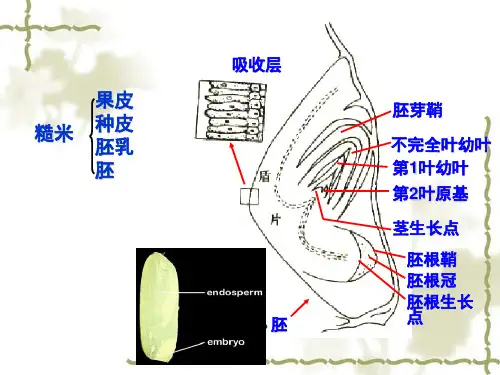
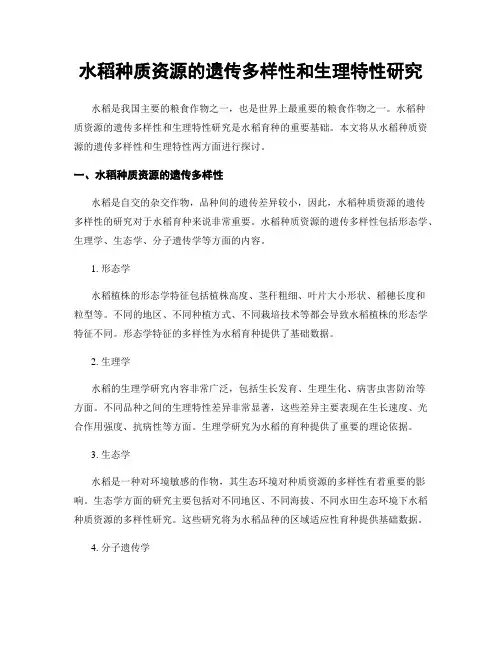
水稻种质资源的遗传多样性和生理特性研究水稻是我国主要的粮食作物之一,也是世界上最重要的粮食作物之一。
水稻种质资源的遗传多样性和生理特性研究是水稻育种的重要基础。
本文将从水稻种质资源的遗传多样性和生理特性两方面进行探讨。
一、水稻种质资源的遗传多样性水稻是自交的杂交作物,品种间的遗传差异较小,因此,水稻种质资源的遗传多样性的研究对于水稻育种来说非常重要。
水稻种质资源的遗传多样性包括形态学、生理学、生态学、分子遗传学等方面的内容。
1. 形态学水稻植株的形态学特征包括植株高度、茎秆粗细、叶片大小形状、稻穗长度和粒型等。
不同的地区、不同种植方式、不同栽培技术等都会导致水稻植株的形态学特征不同。
形态学特征的多样性为水稻育种提供了基础数据。
2. 生理学水稻的生理学研究内容非常广泛,包括生长发育、生理生化、病害虫害防治等方面。
不同品种之间的生理特性差异非常显著,这些差异主要表现在生长速度、光合作用强度、抗病性等方面。
生理学研究为水稻的育种提供了重要的理论依据。
3. 生态学水稻是一种对环境敏感的作物,其生态环境对种质资源的多样性有着重要的影响。
生态学方面的研究主要包括对不同地区、不同海拔、不同水田生态环境下水稻种质资源的多样性研究。
这些研究将为水稻品种的区域适应性育种提供基础数据。
4. 分子遗传学分子遗传学是以分子水平研究生物遗传变异的科学,它是水稻种质资源遗传多样性研究的前沿领域。
分子遗传学技术的应用可以快速、准确地对水稻品种进行遗传分析和检测,为水稻品种选育提供了重要的技术手段。
二、水稻种质资源的生理特性水稻种质资源的生理特性主要包括耐逆性、抗病性、抗虫性、品质特性等多个方面。
1. 耐逆性水稻生长发育过程中,会遇到多种逆境胁迫,如干旱、高温、低温、盐碱等逆境胁迫。
不同水稻品种的耐逆性存在差异,因此,对水稻耐逆性的研究对于提高水稻的抗逆能力、增加产量和优化品质具有重要意义。
2. 抗病性水稻的病害种类比较多,如白叶枯病、纹枯病、稻瘟病等。
水稻形态特征与品种分类研究水稻是我国重要的粮食作物之一,也是世界上重要的粮食作物。
由于水稻品种具有多样性和遗传变异性,研究水稻形态特征与品种分类,可以为育种提供重要依据,也为农业生产提供有力支持。
一、水稻形态特征水稻的形态特征是指植株、叶片、花谢、籽粒等部位的形态和结构特征。
其中,植株高度是影响水稻生长的重要因素之一。
水稻的植株表现出矮秆、半矮秆、高秆等不同类型,这也是水稻品种分类的一个重要指标。
叶片形态也是水稻品种差异的一个重要表现,不同品种的叶片形状、大小、颜色等均不相同。
同时,花谢和籽粒也是水稻形态特征的重要体现,不同品种的花谢形态和籽粒大小、形状均存在明显差异。
二、水稻品种分类水稻品种分类是指按照不同的分类标准,将水稻品种进行划分和归类。
水稻品种分类的方法有很多,其中比较常用的方法有形态分类、生理分类和遗传分类等。
形态分类是根据水稻形态特征的差异,将水稻品种划分为矮秆型、中秆型和高秆型等不同类型。
生理分类是根据水稻生长发育的特征,将水稻品种划分为早熟型、中早熟型和晚熟型等不同类型。
遗传分类是根据水稻遗传特征的差异,将水稻品种划分为两系四类,即日本型、印度型、广东型和广西型等不同类型。
三、水稻形态特征与品种分类研究的意义水稻形态特征与品种分类研究的意义在于为水稻育种提供重要依据,同时也能为农业生产提供有力支持。
通过对水稻形态特征的研究和分析,可以更好地了解不同品种的适应性和生长特征,为育种和栽培提供依据。
同时,对水稻品种进行分类对于水稻资源的保存和利用也具有一定的推动作用。
四、水稻形态特征与品种分类研究的方法水稻形态特征与品种分类的研究需要借助多种手段和研究方法,包括外部形态观察、形态测量、数字图像处理、统计学分析等。
其中,数字图像处理和统计学分析是比较常用的方法,可以有效地快速分析和比较不同品种的形态特征,提高分类的准确性和效率。
五、结论水稻形态特征与品种分类研究是一个复杂而又重要的课题,需要借助多种手段和研究方法进行分析和比较。
水稻形态结构水稻(学名:Oryza sativa)是一种重要的粮食作物,也是世界上最重要的农作物之一。
水稻植株呈直立生长,整体形态结构包括根系、茎、叶和穗。
一、根系水稻的根系主要分为两部分:地上部分和地下部分。
地上部分的根系主要负责供应水分和养分,地下部分的根系则负责固定植株和吸收水分和养分。
水稻的根系呈纺锤形,长而细,具有较强的穿透力和吸水能力。
二、茎水稻的茎是直立的,具有较强的韧性和抗倒伏能力。
茎的主要功能是支撑植株,使叶片能够充分接受阳光照射,并将光合产物输送到其他部位。
水稻的茎分为主茎和分蘖茎,主茎生长势较强,分蘖茎则是从主茎的叶腋处分枝而来。
三、叶水稻的叶片呈长条形,叶尖呈尖锐状。
叶片的主要功能是进行光合作用,将阳光能量转化为化学能,为植株提供养分。
水稻的叶片排列成两列,交替生长,叶片之间形成扇形。
每个叶片的叶柄连接到茎上,使叶片能够有效地接受阳光照射。
四、穗水稻的穗是植株的生殖器官,产生水稻籽粒。
穗一般生长在水稻茎的顶端,由许多小穗组成。
小穗是水稻的花序,每个小穗上有许多花粒。
水稻的花粒呈卵形,通常有两个颖壳包裹着。
花粒在授粉后逐渐发育成水稻籽粒。
总结:水稻的形态结构包括根系、茎、叶和穗。
根系负责吸水和吸收养分,茎起支撑作用,叶片进行光合作用,穗产生水稻籽粒。
这些结构相互配合,共同完成水稻的生长和繁殖过程。
了解水稻的形态结构对于种植和栽培水稻具有重要的意义,可以帮助农民科学种植,提高产量。
同时,对于研究水稻的生物学特性和遗传育种也具有重要价值。
水稻形态学特征镉Rice, Morphological Characteristics, Cadmium水稻的形态学特征及其与镉的关系Rice is a major cereal crop that exhibits distinct morphological characteristics.水稻是一种主要的粮食作物,具有明显的形态学特征。
These characteristics include its elongated leaves, panicles bearing numerous grains, and the root system that anchors it in the soil.这些特征包括其狭长的叶片、承载众多谷粒的稻穗以及将其固定在土壤中的根系。
Cadmium (Cd) is a heavy metal that can have negative impacts on rice growth and quality.镉是一种重金属,对水稻的生长和品质具有负面影响。
When present in the soil, cadmium can be absorbed by rice plants, accumulating in various tissues and potentially causing toxicity.当镉存在于土壤中时,可被水稻植株吸收,并在各种组织中积累,可能导致毒性。
Therefore, understanding the morphological characteristics of rice and its interaction with cadmium is crucial for ensuring safe and sustainable rice production.因此,了解水稻的形态学特征及其与镉的相互作用对于确保水稻的安全和可持续生产至关重要。
水稻的形态特征根、茎、叶、穗、谷粒和米粒水稻的形态特征/根、茎、叶、穗、谷粒和米粒1.根属于须根系,有种根和不定根之别。
种根又称初生根,只有一条,由胚根直接发育而成,在幼苗期营吸收作用,以后枯死。
不定根又称永久根,由茎基部的茎节上生出,其上再发生支根。
陆稻、早播稻湿润管理时,嫩根伸长区之上表皮细胞外壁延伸出多量根毛,但在水层中生长的水稻不长根毛或根毛极少。
根的顶端有生长点,外有帽状根冠保护。
根的数量、长度、分布、伸展角度等因环境条件而变化。
根的横剖面由中柱、皮层和表皮等三部分构成,中柱内有木质部的大导管十余个成辐射状排列,韧皮部与后生木质部相间排列。
皮层细胞间隙扩大呈空洞,形成裂生通气组织,以进行气体的输送。
2.茎一般呈圆筒形,中空,茎上有节。
叶着生在节上,上下两节之间称节间。
茎基部有7~13个节间不伸长,称为蘖节;茎的上部有4~7个明显、伸长的节间,形成茎秆。
一般生育期长的品种茎节数和伸长节间数较多,生育期短的品种较少。
节表面隆起,内部充实,外层是表皮,细胞壁很厚,节组织中的厚壁细胞充满原生质,生活力旺盛,比其他部分含有较多的糖分、淀粉等。
节的髓部与其上下节中心腔分界处具有肥厚细胞壁的石细胞层,称横隔壁,将两个中心腔隔开。
叶、分蘖及根的输导组织都在茎内汇合,因此节内维管束的配置比较复杂。
节间的横剖面可分为表皮、下皮、薄壁组织、维管束和机械组织各部分。
内部有中心腔,外部有纵沟,每个节间下部幼嫩部分有分生组织,称居间分生组织,由叶鞘保护。
茎节是稻株体内输气系统的枢纽,各方面的通气组织在此相互联通,节部通气组织还与根的皮层细胞相连,所以这种从叶片到根系间以茎节部通气组织为枢纽的完善的输气系统是旱生禾谷类作物所没有的。
3.叶互生于茎的两侧,为1/2叶序。
主茎叶数与茎节数一致,其数目多少与品种、生育期有直接关系。
早熟品种约有9~13片叶;中熟品种约有14~16片叶;晚熟品种的叶数在16片以上。
稻叶可分为叶鞘和叶片两部分,在其交界处有叶枕、叶耳和叶舌。
Table Of ContentsTABLE OF CONTENTS (1)MORPHOLOGY OF THE RICE PLANT (2)Germinating seed (2)Seedling (4)Tiller (6)Culm (8)Leaf (12)Panicle and Spikelets (18)Floret (24)Flower (27)Rice grain (29)PRINT VERSION (31)INDEX (32)Morphology of the Rice PlantGerminating seedWhen the seed germinates in well-drained and well-aerated soil, the coleorhiza, a covering enclosing the radicle or primary root, protrudes first.Fig. 1 - The coleorhiza protrudes first.Shortly after the coleorhiza appears, the radicle or primary root breaks through the covering. Fig. 2 - Radicle or primary root breaks through the covering.Two or more sparsely branched seminal roots follow. These roots eventually die and are replaced by many secondary adventitious roots.Fig. 3 - Seminal rootsIf the seed germinates in water, the coleoptile, a covering enclosing the young shoot, emerges ahead of the coleorhiza. The coleoptile emerges as a tapered cylinder.Fig. 4 - Coleoptile emerging as a tapered cylinder.SeedlingThe mesocotyl or basal portion of the coleoptile elongates when the seed germinates in soil, and in darkness. It pushes the coleoptile above the soil surface.Fig. 5 - Mesocotyl pushing the coleoptile above the soil surface.The first seedling leaf, or primary leaf, emerges from the growing seed. It is green and shaped like a cylinder. It has no blade. The second leaf is a complete leaf. It is differentiated into a leaf blade and a leaf sheath.Fig. 6 - First and second seedling leaf.TillerThe seedling will grow and develop branched tillers. Parts of the rice tiller include the roots, culm and leaves. Mature roots of the rice plant are fibrous and produce smaller roots called rootlets. All roots have root hairs to absorb moisture and nutrients.Fig. 7 - Parts of the rice tiller.There are two kinds of mature roots:1. secondary adventitious roots2. adventitious prop roots prop roots.Fig. 8 - Types of roots.Secondary adventitious roots are produced from the underground nodes of young tillers.Fig. 9 - Secondary adventitious roots.As the plant grows, coarse adventitious prop roots often form above the soil surface in whorls from the nodes of the culm.Fig. 10 - Adventitious prop roots.CulmThe culm, or jointed stem of the rice, is made up of a series of nodes and internodes. Fig. 11 - Culm, nodes, and internodes.Young internodes are smooth and solid. Mature internodes are hollow and finely grooved with a smooth outer surface. Generally, internodes increase in length from the lower to the upper portions of the plant. The lower internodes at the plant base are short and thick.Fig. 12 - Young and mature internodes.The node is the solid portion of the culm. The node or nodal region bears a leaf and a bud. The bud is attached to the upper portion of the node and is enclosed by the leaf sheath. The bud may give rise to a leaf or a tiller.Fig. 13 - Leaf, node, and bud.Early tillers arise from the main culm in an alternate pattern. Primary tillers originate from the lowermost nodes and give rise to secondary tillers. Secondary tillers produce tertiary tillers. Fig. 14 - Primary tillers.Fig. 15 - Secondary tillers. Fig. 16 - Tertiary tillers.LeafThe node or nodal region of the culm will bear a leaf. Fig. 17 - Leaf.Leaves are borne alternately on the culm in opposite directions. One leaf is produced at each node. Varieties differ in the number of leaves produced.Fig. 18 - Leaves alternate on the culm in opposite directions.The topmost leaf below the panicle is the flag leaf. The flag leaf contributes largely to the filling of grains because it supplies photosynthetic products, mainly to the panicle.Fig. 19 - Flag leaf.The leaf sheath and leaf blade are continuous.Fig. 20 - Leaf sheath and blade.A circular collar joins the leaf blade and the leaf sheath.Fig. 21 - Leaf collar.The leaf sheath is wrapped around the culm above the node. Fig. 22 - Leaf sheath and culm.The swelling at the base of the leaf sheath, just above the node, is the sheath pulvinus. It is sometimes incorrectly referred to as the node.Fig. 23 - Sheath pulvinus.Leaf blades are generally flat. Varieties differ in blade length, width, thickness, area, shape, color, angle and pubescence.Fig. 24 - Different varieties with varying blade characteristics.With many parallel veins on the upper surface of the leaf, the underside of the leaf blade is smooth with a prominent ridge in the middle; the midrib.Fig. 25 - Parallel veins on upper surface. Fig. 26 - Leaf midrib.Most leaves possess small, paired ear-like appendages on either side of the base of the blade. These appendages are called auricles. Auricles may not be present on older leaves. Another leaf appendage is the ligule, a papery membrane at the inside juncture between the leaf sheath and the blade. It can have either a smooth or hair-like surface. The length, color, and shape of the ligule differ according to variety.Fig. 27 - Ligule and auricle.Although similar, rice seedlings are different from common grasses. While rice plants have both auricles and ligules, common grassy weeds found in rice fields normally do not have these features. These characteristics are often helpful in identifying weeds in rice fields when the plants are young.Fig. 28 - Rice and grassy weed comparison.Panicle and SpikeletsThe terminal component of the rice tiller is an inflorescence call the panicle. The inflorescence or panicle is borne on the uppermost internode of the culm. The panicle bears rice spikelets, which develop into grains.Fig. 29 - Rice panicle.The panicle base often appears as a hairlike ring and is used as a dividing point in measuring culm and panicle length. The panicle base is often called the neck.Fig. 30 - Panicle base (neck).The panicle axis is continuous and hollow except at the nodes where branches are borne. Fig. 31 - Panicle axis.The swellings at the panicle axis where the branches are borne are referred to as the panicle pulvinus.Fig. 32 - Panicle pulvinus.Each node on the main panicle axis gives rise to primary branches which in turn bears secondary branches. Primary branches may be arranged singly or in pairs.Fig. 33 - Secondary and primary branch.The panicles bear spikelets, most of which develop into grains. These spikelets are borne on the primary and secondary branches. The spikelet is the basic unit of the inflorescence and panicle. It consists of the pedicel and the floret.Fig. 34 - Spikelets.The floret is borne on the pedicel.Fig. 35 - Floret and pedicel.The rudimentary glumes are the laterally enlarged, cuplike apex of the pedicel. The rudimentary glumes are the lowermost parts of the spikelet. During threshing, the rudimentary glumes are separated from the rest of the spikelet.The sterile lemmas are small, bractlike projections attached to the floret. The rachilla is a small axis that bears the single floret. It is between the sterile lemmas and the floret.Fig. 36 - Rudimentary glumes, sterile lemmas, and rachilla.FloretThe rachilla, sterile lemmas and the rudimentary glumes all support the floret. The floret includes the lemma, palea, and the flower.Fig. 37 - FloretThe larger protective glume covering the floret is called the lemma and the smaller one is referred to as the palea.Fig. 38 - Palea and lemma.Both the lemma and palea have ridges referred to as nerves. The lemma has five while the palea has three. The middle nerve of the lemma can be either smooth or hairy.Fig. 39 - Nerves.The lemma has a constricted structure at its end called the keel. In some varieties, the keel is elongated into a thin extension, the awn.Fig. 40 - Awn and keel.FlowerThe floret contains a flower. The flower consists of a pistil (female organ) and six stamens (male organs).Fig. 41 - Pistil.Fig. 42 - Stamens.The stamens have two-celled anthers borne on slender filaments.Fig. 43 - Anthers and filaments.The pistil contains one ovule and bears a double-plumed stigma on a short style. Fig. 44 - Stigma, style, and ovule.At the flower’s base near the palea are two transparent structures known as lodicules. The lodicules thrust the lemma and palea apart at flowering to enable the elongating stamens to emerge out of the open floret. The lemma and palea close after the anthers have shed their pollen.Fig. 45 - Lodicule.Rice grainThe rice grain is the ripened ovary, with the lemma, palea, rachilla, sterile lemmas and the awn firmly attached to it.Fig. 46 - Rice grain.The rice hull includes the lemma and palea and their associated structures – the sterile lemmas, rachilla, and awn.Fig. 47 - Rice hulls.The dehulled rice grain is called caryopsis, commonly referred to as brown rice because of three brownish pericarp layers that envelope it. Next to the pericarp layers are the two tegmen layers and the aleurone layers.Fig. 48 - Tagmen, pericap, and aleurone layers.The remaining part of the grain consists of the endosperm and the embryo. The endosperm provides nourishment to the germinating embryo. The embryo lies on the belly side of the grain and is enclosed by the lemma. It is the embryonic organ of the seed.Fig. 49 - Endosperm and embryo.The embryo contains the plumule (embryonic leaves) and the radicle (embryonic primary root).Fig. 50 - Plumule and radicle.Print VersionCultural Control of Rice Insect Pests may also be completely printed, provided you have a printer attached to your computer and Microsoft Word. Click here to launch the entire contents of this course in Microsoft Word.IndexAAdventitious (4)Aleurone (24)Anthers (22)Asian (27)Awn (20)B Bractlike (15)C Caryopsis (24)Characteristics (10)Coleoptile..............................................................................................................................2, 3 portion .. (3)pushes (3)Coleorhiza (2)Contains (24)plumule (24)Culm ................................................................................................................... 4, 6, 10, 15, 27 measuring (15)portion (6)Cuplike (15)D Dehulled (24)Different (10)EEndosperm (24)FFirst (3)Flag (10)Floret ................................................................................................................................ 15, 20 Flower.. (22)Flower’s (22)G Germinating (2)seed (2)Glume (20)Glumes............................................................................................................................. 15, 20 I Index. (27)use (27)L Leaf..................................................................................................................................... 6, 10 Leaves. (10)Ligule (10)shape (10)Ligules (10)Lodicule (22)Lodicules (22)M Measuring (15)culm (15)Mesocotyl (3)Morphology (27)Rice Plant (27)Welcome (27)NNear (22)palea (22)Nerves (20)OOryza sativa (27)P Palea........................................................................................................................... 20, 22, 24 near .. (22)Panicle (15)Panicle pulvinus (15)Parallel (10)Parts ................................................................................................................................... 4, 15 spikelet .. (15)Pedicel (15)Pericap (24)Pericarp (24)Pistil (22)Plumule (24)contains (24)Portion...................................................................................................................................3, 6 coleoptile. (3)culm (6)Primary (6)Pulvinus........................................................................................................................... 10, 15 Pushes .. (3)coleoptile (3)RRachilla ...................................................................................................................... 15, 20, 24 Radicle .. (2)Rest (15)spikelet (15)Rice............................................................................................................................. 10, 15, 24Rice grain (24)Rice Morphology (27)Rice Plant (27)Morphology (27)Rice Production (27)Rudimentary glumes (15)SSearch (27)Secondary...................................................................................................................... 4, 6, 15 Seed. (2)Germinating (2)Seminal (2)Shape (10)ligule (10)Sheath pulvinus (10)Spikelet (15)parts (15)rest (15)Spikelets (15)Stamens (22)Stigma (22)TTagmen (24)Tertiary (6)The coleorhiza (2)These characteristics (10)These spikelets (15)Tiller (4)Types (4)U Use (27)Index (27)WWelcome (27)Morphology (27)Y Young (6)。